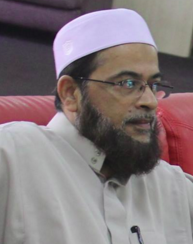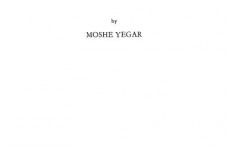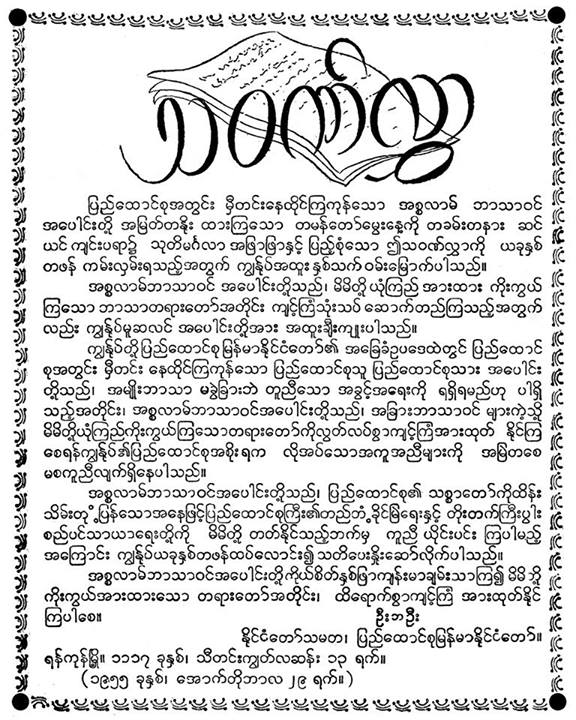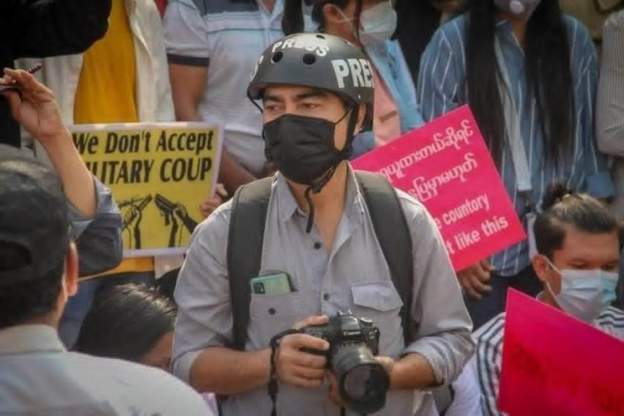Muslims Mercenaries in Burmese history
The first Muslim recorded in Burmese history
The first Muslim documented in Burmese history (recorded in Hmannan Yazawin or Glass Palace Chronicle) was Byat Wi during the reign of Mon, a Thaton King, circa 1050 AD.[1]
Shwe Byin brothers executed
The two sons of Byat Wi’s brother Byat Ta, known as Shwe Byin brothers, were children executed because they refused to obey the forced labour order of the king, maybe because of their religious belief.[2] It was clearly recorded in the Glass Palace Chronicle of the Kings of Burma that they were no longer trusted.[3]
Assassination of Nga Yaman Kan
Rahman Khan (Nga Yaman Kan) was another Muslim killed for political reasons, because of treason to his own king and also clearly as religious persecution.[citation needed] During a time of war, King Kyansittha sent a hunter as a sniper to assassinate him.[4][5]
Massacre in Arakan
Another event involving killing of Muslims was in Arakan and was likely due to politics and greed and not communal and religious agenda. Shah Shuja was the second son of the Mogul Emperor Shah Jahan who built the famous Taj Mahal of India. Shah Shuja lost to his brother Aurangzeb and fled with his family and soldiers to Arakan. The Arakan pirate king Sandathudama (1652-1687 AD) who was the local pirate of Chittagong and Arakan, allowed him to settle there. He wanted to buy ships to go to Mecca and was willing to pay with silver and gold. But the Arakan king turned greedy for his wealth and forced on his daughter. At last after an alleged unsuccessful attempt at rebellion the sultan and most of his followers were killed. There are sources that indicate that Shah Shuja escaped the massacre.[6][7][8][9][10][11][12]
Muslims under Bayintnaung
Muslims served under Burmese king Bayintnaung (1550-1589 AD).[13] In 1559 AD after conquering Bago (Pegu) he prohibited the Muslims from having halal meals of goats and chickens by not allowing them to kill these animals in the name of God. He also disallowed the Eid ul Adha, Kurbani, sacrifice of cattle.[14]
Muslims under Alaungpaya
King Alaungpaya (1752–1760) prohibited Muslims to do halal on cattle.[15]
Bodawpaya
King Bodawpaya (1782–1819) arrested four famous Burma Muslim Maulvis (Imams) from Myedu and killed them in Ava, the capital, after they refused to eat pork.[16] According to the Myedu Muslim and Burma Muslim version there were seven dark days after that execution and the king later apologized and recognized them as saints.[17][18]
Anti-Muslim and anti-Indian Riots under British rule
British Official White Paper
He was the judge in Rangoon, eyewitness to the riots, who wrote his book based on the British Official White Paper given by The Simon Commission (The Royal Statutory Commission, appointed according to the Law of the Government of India 1919, The Montague-Chelmsford Law.)[19]
Anti-Indian and anti-Muslim sentiments started during British rule
Anti-Indian sentiments started after the First World War during the British rule.[20] In Burma there were a half million Muslims in 1921. More than half of Indians were Indian Muslims.[21] Although Burma Muslims are different from Indian Muslims and Indian Burma Muslims, Burmese Buddhists put them together, even with Hindu Indians, and called them Kala.[19]
The root of these actions were:[19][22]
- Earlier Muslim persecution of Buddhists and Hindus during the Mughal wars of conquest, where many Buddhists and Hindus were forcibly converted.
- Low standard of living of the recent migrants.
- Recent migrants’ willingness to do, dirty, difficult and dangerous jobs.
- Indians took over the Burmese lands especially Chittiers.
- Indians had already filled up and monopolized the government services when the Burmese were later ready for those jobs.
- Professional competition.
- World economic recession of 1930 aggravated the competition for the reduced economic pie.
1930 Anti-Indian riots
In 1930 there were anti-Indian riots in Burma under British rule.
The problem started in Yangon port, because of the irresponsible action of a British firm of stevedores which had employed hundreds of Indian labourers. While those Indians were on strike, that firm had employed the Burmese workers just to break the strike. So the Indians had to give in and ended the strike. Next morning when the Burmese workers came and reported for work they were told by the British firm that their service was no longer needed. Some Burmese workers were angry and started the fight and Indians retaliated. It grew rapidly into an anti-Indian (including anti-Muslim) riot. Even within the first half-hour at least two hundred Indians were massacred and flung into the river. Authorities ordered the police to fire upon any assembly of five or more who refused to lay down their arms, under Section 144 of the Criminal Procedure Code. That was a black day of 26 May. Within two days the riot spread to the whole country and no one knew the exact causality.[19]
1938 Anti-Muslim riots
There was an anti-Muslim riot in 1938, while Burma was still under British rule. The real agenda was aimed at British government but the Burmese dare not show this openly. Growing Nationalistic sentiments were fanned by the local media and disguised as anti-Muslim to avoid early detection and notice. It was followed by the full blown force of the mighty British Government machinery. Throughout the Burmese struggles against British rule, all the political issues, movements, meetings, demonstrations, riots, rebellions and even the revolutions were instigated, inspired, influenced and led by newspapers.[23][24]
Burma for Burmese Only Campaign
The Burmese started the Burma for Burmese only Campaign and marched to the Muslim (Surti) Bazaar.[25] While the Indian Police broke the violent demonstration, three monks were hurt. Burmese newspapers use the pictures of Indian police attacking the Buddhist monks to further incite the spread of riots.[26] Muslim properties: shops, houses and mosques were looted, destroyed and burned. They assaulted and even massacred the Muslims. It spread all over Burma and a recorded 113 mosques were damaged.[27]
The Inquiry Committee by the British
On September 22, 1938, the British Governor set up the Inquiry Committee.[28] They found out that the real cause was the discontent in the government regarding the deterioration in sociopolitical and economic conditions of Burmans.[29] The book was used as an inciting factor by the irresponsible Burmese newspapers.[30]
The Simon Commission (The Royal Statutory Commission, appointed according to the Law of the Government of India in 1919, The Montague-Chelmsford Law) an inquiry of the effects of Dyarchy system of ruling Burma, had recommended that special places be assigned to the Burma Muslims in the Legislative Council.
It recommended that full rights of citizenship should be guaranteed to all minorities: the right of free worship, the right to follow their own customs, the right to own property and to receive a share of the public revenues for the maintenance of their own educational and charitable institutions. It recommended Home Rule or independent government separate from India or the status of dominion.
But the British Government did not accept all these recommendations except for separation, at the round table committee on India held in London in 1930.
Muslims under U Nu
AFPFL expelled the Burma Muslim Congress[31]
The BMC, Burma Muslim Congress was founded almost at the same time with the AFPFL, Anti-Fascist Peoples’ Freedom Party of General Aung San and U Nu before World War II . On December 25, 1945 in Pyinmana, U Razak was elected President of BMC and decided to join AFPFL. U Razak was elected AFPFL President in the Mandalay district in 1946. Later the Governor accepted him as the member of constitutional council. He had good relations with Buddhists and was fluent in Pali (Buddhist scriptures are written in this ancient language of India). He became the Minister of Education and Planning in Bogoke’s (General Aung San) Government and was later assassinated with him.[32] But he had supported the main policy of the AFPFL: that is against the partition along community or religious lines. U Razak and his few associates objected to the struggle of those demanding specific constitutional guarantees for the Burma Muslim minority. So, although U Razak was a prominent Burma Muslim leader who had successfully organized Burma Muslims to be able to get an official record that they had participated since the very beginning of the Burmese National struggle towards independence.
His stand of united Burmese (Burma) nation sacrificing the long-term interest of guarantee for the rights of Minority Burma Muslim satisfied not only the Burmese Buddhist leaders of the AFPFL, but also the British Government. Maybe because of that he got a lot of personal rewards. U Raschid and more prominently U Khin Maung Lat, follows the general policy of sacrificing the Rights and Interests of the Burma Muslim Community for ‘the country and their party’. Prime Minister U Nu, just a few months after the independence of Burma, requested the Burma Muslim Congress to resign its membership from AFPFL. In response to that U Khin Maung Lat, the new President of BMC, decided to discontinue the Islamic Religious activities of the BMC and rejoined the AFPFL. Later he became Minister of Justice but no longer represented the wishes of the Burma Muslim community. The newly-formed Burmese Muslim League requested a special government department for Muslim affairs to determine their own future, the same as for other minorities, who had Ministries in Yangon and governments in their states. U Nu removed the Burma Muslim Congress from AFPFL on September 30, 1956. BMC was asked to dissolve since 1955.
Later U Nu decreed Buddhism as the state religion of Burma against the will of the ethnic minorities and various religious organizations including Burma Muslims. U Nu, a Buddhist, was pressured by the wealthy and influential Hindi merchants who ordered the prohibition of the slaughtering of cattle. Although he relaxed that during the Kurbani Edd (Hari Raya Haji), Muslims had to apply the permits for each cattle and strictly follow procedures under police supervision. Although General Ne Win revoked the first order and allowed the slaughter of cattle for daily consumption, the second order of restriction for the sacrifice remained up to the present. Some Muslims complained that U Nu’s government had made more difficult conditions and regulations for the Haj pilgrimage than the Buddhists pilgrims going to Sri Lanka and Nepal
Muslims under General Ne Win
When General Ne Win came to power in 1962, the status of Muslims changed. For example. Muslims were expelled from the army. [5] Burma has a Buddhist majority. The more pious Muslim communities who segregate themselves from the Buddhist majority face greater difficulties than those who integrate more at the cost of observance to Islamic personal laws.[33]
Muslims in Burma are affected by the actions of Islamic extremism in other countries. Violence in Indonesia perpetrated by Islamists is used as a pretext to commit violence against Muslim minorities in Burma.[citation needed] The anti-Buddhist actions of the Taliban in Afghanistan (the destruction of the Buddhas of Bamiyan) was also used as a pretext to commit violence against Muslims in Burma by Buddhist mobs. Human Rights Watch reports that there was mounting tension between the Buddhist and Muslim communities in Taungoo for weeks before it erupted into violence in the middle of May 2001. Buddhist monks demanded that the Hantha Mosque in Taungoo be destroyed in “retaliation” for the destruction of the Buddhas of Bamiyan.[34] Mobs of Buddhists, led by monks, vandalized Muslim-owned businesses and property and attacked and killed Muslims in Muslim communities. This was followed by retaliation by Muslims against Buddhists.
Religious freedom for Muslims is reduced. Monitoring and control of Islam undermines the free exchange of thoughts and ideas associated with religious activities.[6] Accusations of “terrorism” are made against Muslim organizations such as the All Burma Muslim Union.[7]</ref>
It is widely feared that persecution of Muslims in Burma could foment Islamic extremism in the country.[35] Many Muslims have joined armed resistance groups who are fighting for greater freedoms in Burma.[36]
1997 Anti-Muslim Riots in Mandalay
The racial tension in March 1997 between Buddhists and Muslims and the attack on Muslim properties began during the renovation of a Buddha statue. The bronze Buddha statue in the Maha Myatmuni pagoda, originally from the Arakan, brought to Mandalay by King Bodawpaya in 1784 AD was renovated by the authorities. The Mahamyat Muni statue was broken open, leaving a gaping hole in the statue, and it was generally presumed that the regime was searching for the Padamya Myetshin, a legendary ruby that ensures victory in war to those who possess it.[37]
On 16 March 1997 beginning at about 3:30 p.m., a mob of 1,000-1,500 Buddhist monks and others shouted anti-Muslim slogans.They targeted the mosques first for attack, followed by Muslim shop-houses and transportation vehicles in the vicinity of mosques, damaging, destroying, looting, and trampling, burning religious books, committing acts of sacrilege. The area where the acts of damage, destruction, and lootings were committed was Kaingdan, Mandalay.[38] The unrest in Mandalay began after reports of an attempted rape of a girl by Muslim men, although this was later disproved and led to speculation that the regime may have orchestrated the incident to deflect anger from the damaged statue. At least three people were killed and around 100 monks arrested.[39]
2001 Anti-Muslim Riots in Taungoo
In 2001,Myo Pyauk Hmar Soe Kyauk Sa Yar (or) The Fear of Losing One’s Race and many other anti-Muslim pamphlets were widely distributed by monks. Many Muslims feel that this exacerbated the anti-Muslim feelings that had been provoked by the destruction in Bamiyan, Afghanistan.[40] On May 15, 2001, anti-Muslim riots broke out in Taungoo, Pegu division, resulting in the deaths of about 200 Muslims, in the destruction of 11 mosques and the setting ablaze of over 400 houses. On May 15, the first day of the anti-Muslim uprisings, about 20 Muslims who were praying in the Han Tha mosque were killed and some were beaten to death by the pro-junta forces. On May 17, Lt. General Win Myint, Secretary No.3 of the SPDC and deputy Home and Religious minister, arrived in Taungoo and curfew was imposed there until July 12, 2001.[41] Buddhist monks demanded that the ancient Hantha Mosque in Taungoo be destroyed in retaliation for the destruction in Bamiyan.[42] On May 18, however, Han Tha mosque and Taungoo Railway station mosque were razed to the ground by bulldozers owned by the SPDC junta.[43] The mosques in Taungoo remained closed as of May 2002. Muslims have been forced to worship in their homes. Local Muslim leaders complain that they are still harassed. After the violence, many local Muslims moved away from Taungoo to nearby towns and to as far away as Yangon. After two days of violence the military stepped in and the violence immediately ended.[44]
References
- Pe Maung Tin and G. H. Luce, The Glass Palace Chronicle of the Kings of Burma, Rangoon University Press, Rangoon, Burma, January 1960
- Yegar, Moshe The Muslims of Burma: a Study of a Minority Group, Otto Harrassowitz, Wiesbaden, 1972; p. 2, paragraph 3
- Pe Maung Tin and G. H. Luce, The Glass Palace Chronicle of the Kings of Burma p. 83 paragraph 3, lines 2&3
- Yegar Muslims; p. 2, lines 1&2
- Pe Maung Tin and G. H. Luce, The Glass Palace Chronicle of the Kings of Burma, p. 103, paragraph 3
- Yegar Muslims; p. 21, paragraph 2; pp. 22-24.
- Colonel Ba Shin, Coming of Islam to Burma down to 1700 AD, Lecture at the Asia History Congress. New Delhi: Azad Bhavan 1961 Mimo.
- H. R. Spearman, British Burma Gazetteer (Rangoon, 1880); I, pp. 293-294.
- Hall, History of South East Asia, pp. 33-341.
- Desai, A Pageant of Burmese History, pp. 61-63.
- Harvey, G .E. “The fate of Shah Shuja”, 1661, JBRS, XII (Aug 1922) pp. 107-112.
- http://books.google.co.in/books?id=AV–abKg9GEC&pg=PA318&lpg=PA318&dq=Gulrukh+Banu&source=bl&ots=iI-jQ2IE3e&sig=Pl9_DYbWfN7JSzzOuEt4j6L4Oes&hl=en&sa=X&ei=iwQQUIC2H6iYmQWCpoGQCQ&ved=0CDkQ6AEwAQ#v=onepage&q=Gulrukh%20Banu&f=false
- Yegar Muslims; p. 10, lines 11&12
- Yegar Muslims; p. 10, lines 10-16
- Yegar Muslims; p. 10, line 21
- Yegar Muslims; p. 12, paragraph 3
- Yegar Muslims; p. 12, paragraph 3
- Siddiq Khan, M., “Captain George Sorrel’s Mission to the court of Amarapura, 1793-4″, Journal of the Asiatic Society of Pakistan (Dacca); II (1957), pp. 132-140
- a b c d Collis, Maurice, Trials in Burma
- Yegar Muslims; p. 32
- Yegar Muslims; p. 29 paragraph 1 and footnote 1; p. 31 lines 1, 2, 11
- Yegar Muslims; p.111, paragraph 4, lines 8-15; p. 27, paragraph 4, lines 5-7; p. 31, paragraph 2; p. 32, paragraph 4
- Democratic Voice of Burma, Media conference (July 19–20, Oslo) Burmese Media: Past, present and future by U Thaung (Mirror/Kyae Mon news paper Retired Chief Editor)
- ^Yegar Muslims; p. 32, paragraph 4; p. 36, paragraph 1, lines 6, 7, 8, 9, 11, 12, 14, 15
- Yegar Muslims; p.3 6, paragraph 3.
- Yegar Muslims; p. 36, paragraph 4; p. 37 lines 1, 2
- Yegar Muslims; p. 37, paragraph 2.
- Yegar Muslims; p.38, line 1
- Yegar Muslims; p. 38, paragraph 2
- Yegar Muslims; p. 38, paragraph 2, lines 12-14
- Yegar Muslims; pp. 75-79
- Yegar Muslims; p. 75 footnote last paragraph
- http://hrw.org/backgrounder/asia/burma-bck4.htm#P103_22688
- http://www.hrw.org/legacy/backgrounder/asia/burma-bck4.htm#P103_22688
- http://www.khrg.org/khrg2002/khrg0202.html
- http://www.khrg.org/khrg2002/khrg0202.html
- ^ Houtman, Gustaaf. Mental Culture in Burmese Crisis Politics: Chapter 5 Study of Languages and Cultures of Asia and Africa Monograph Series No. 33. Tokyo University of Foreign Studies, Institute for the Study of Languages and Cultures of Asia and Africa, 1999, 400 pp. ISBN 4-87297-748-3
- Images Asia: Report on the Situation for Muslims in Burma May 1997 http://www.ibiblio.org/freeburma/ethnic/rohingya1.txt
- March| Data | Chronology for Rohingya (Arakanese) in Burma
- Crackdown on Burmese Muslims, July 2002 http://hrw.org/backgrounder/asia/burmese_muslims.pdf
- Burma Net News:July 16, 2001 http://www.burmalibrary.org/reg.burma/archives/200107/msg00034.html
- Crackdown on Burmese Muslims, Human Rights Watch Briefing Paper http://hrw.org/backgrounder/asia/burma-bck4.htm
- Crackdown on Burmese Muslims, Human Rights Watch Briefing Paper http://hrw.org/backgrounder/asia/burma-bck4.htm
- Crackdown on Burmese Muslims, Human Rights Watch Briefing Paper http://hrw.org/backgrounder/asia/burma-bck4.htm
Source: http://en.wikipedia.org/wiki/Persecution_of_Muslims_in_Myanmar








